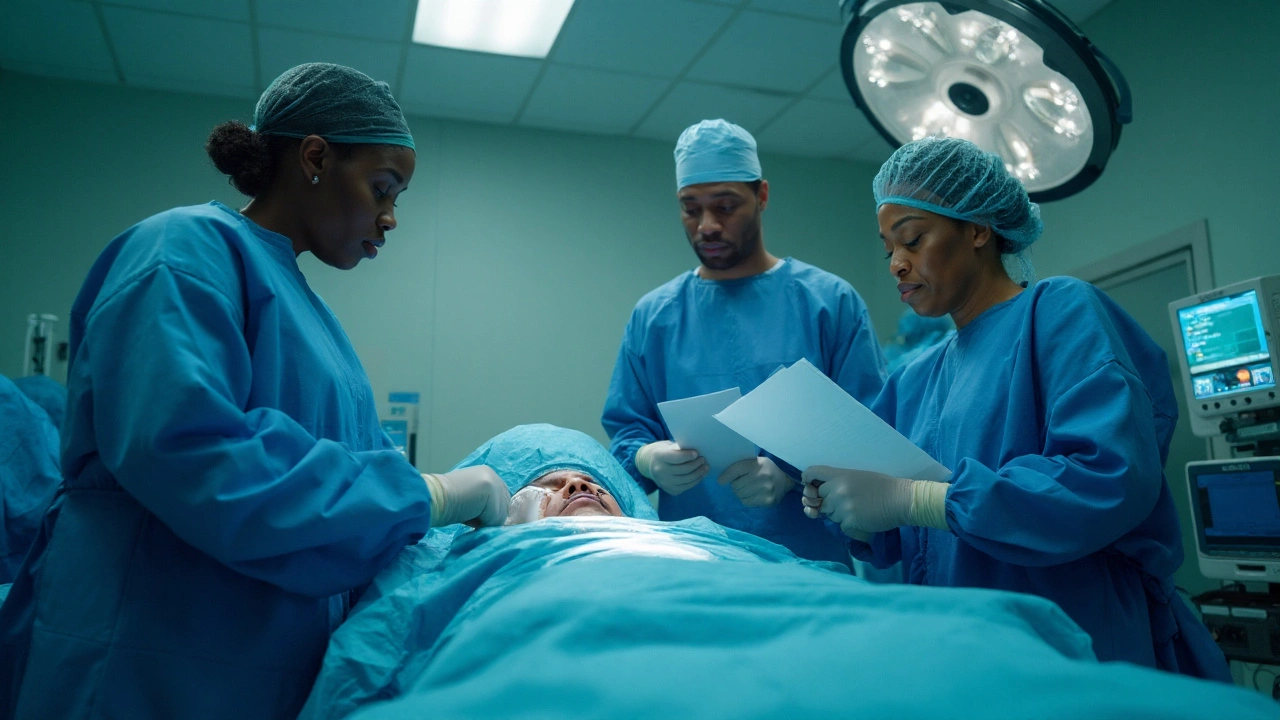You clicked this because “vaginal surgery” gets used for wildly different things-from fixing a prolapse to reshaping labia to creating a vagina during gender-affirming care. Here’s the clean, no-nonsense map of what’s what, when it’s used, what recovery actually looks like, and how to choose a surgeon without guesswork. No hype, no scare tactics-just real options, trade‑offs, and next steps.
- Most people mean one of five buckets: reconstructive/urogynecology, obstetric repair, aesthetic/cosmetic, oncologic, or gender‑affirming surgery.
- Good surgery starts with the right diagnosis and conservative options first (pelvic floor PT, pessaries, hormones, meds) when appropriate.
- Recovery ranges from 1-2 weeks (minor) to months (major reconstruction). Sex is usually on hold 4-12 weeks depending on the procedure.
- Outcomes vary: midurethral slings cure stress incontinence in ~70-85%; labiaplasty satisfaction ~90%+; prolapse can recur (20-30% over years).
- Pick surgeons by training, case volume, outcomes, and how well they explain risks-not by before/after photos alone or “rejuvenation” marketing.
What “vaginal surgery” actually covers (and what it doesn’t)
First, quick anatomy. The vagina is the muscular canal inside the pelvis. The vulva is the outside-the labia, clitoral hood, and vaginal opening. People often say “vaginal surgery” when they mean procedures on the vulva or the pelvic floor. Getting the names right helps you find the right specialists and the right info.
Here’s the map of the main vaginal surgery types you’ll see:
- Reconstructive and urogynecology: prolapse repairs (anterior/posterior colporrhaphy), apical suspension (sacrospinous fixation, uterosacral suspension), abdominal/robotic sacrocolpopexy, stress incontinence procedures (midurethral sling), fistula repair.
- Obstetric repair and scar revision: repair of perineal tears/episiotomies, perineorrhaphy, revision of painful scars.
- Aesthetic or functional vulvar procedures: labiaplasty (trim or wedge), clitoral hood reduction, mons liposuction, “vaginal tightening” (usually a perineal muscle/fascia repair), hymenoplasty, vestibulectomy for localized vestibulodynia.
- Oncologic surgery: partial or total vaginectomy or vulvectomy, with reconstructive flap surgery when needed.
- Gender-affirming surgery: creation of a vagina (vaginoplasty) using penile inversion, scrotal grafts, or peritoneal/intestinal tissue; vulvoplasty without canal; revisions.
What’s not on this list: cesarean sections, routine D&C, and office-based lasers marketed for “rejuvenation.” Energy-based devices (CO2/erbium lasers, radiofrequency) aren’t the same as surgery. In 2018 the U.S. FDA warned about aggressive marketing of these for sexual function and urinary symptoms. Some menopausal dryness symptoms can improve with specific devices, but guidelines (ACOG, 2020-2023) still call the evidence mixed. If you’re considering devices, ask about published data, not testimonials.
The main procedures and when each is used
Use this section to translate symptoms into likely options. Not a diagnosis-just the usual playbook surgeons discuss.
Pelvic organ prolapse (pressure, a bulge, bowel or bladder issues)
- Native tissue repairs: anterior colporrhaphy (front wall), posterior colporrhaphy (back wall with rectocele), perineorrhaphy (tightens the perineal body), and apical suspension (uterosacral or sacrospinous ligament). Done vaginally, no mesh. Good for many patients; recurrence risk exists over time.
- Abdominal/robotic sacrocolpopexy: mesh is attached to the top of the vagina and the sacrum through the abdomen. Often used for advanced prolapse or recurrent cases; durable support with small but real mesh risks. U.S. transvaginal mesh for prolapse was pulled from the market in 2019, but abdominal mesh sacrocolpopexy remains standard.
- Alternatives: pessary fitting, pelvic floor PT, weight and constipation management, local estrogen for post‑menopausal tissue support.
Stress urinary incontinence (leak with cough/sneeze/lift)
- Midurethral sling (retropubic or transobturator): a synthetic tape supports the urethra. Cure or strong improvement in ~70-85% at 1-5 years in large registries (AUGS, international cohorts). Mesh here is not the same as banned transvaginal mesh for prolapse.
- Other options: urethral bulking agents (office procedure, less durable), older procedures like Burch colposuspension (abdominal), pelvic floor PT, weight loss, cough control.
Fistula repair (urine or stool leaking from the vagina)
- Vesicovaginal or rectovaginal fistula repair: meticulous surgery with layered closure; sometimes tissue flaps to bolster blood supply. Success often exceeds 80-90% in experienced hands, but complexity varies.
Congenital differences or painful septum
- Vaginal septum excision: removes a dividing wall in the vagina causing pain or tampon issues.
- MRKH or absent vagina: creation using skin grafts, peritoneal flaps (Davydov/peritoneal vaginoplasty), or dilation without surgery (first‑line in many guidelines, like ACOG and RCOG).
Obstetric repair and scar revision
- Primary repair of tears during birth: done at the time of delivery.
- Revision perineorrhaphy: for pain, gaping, or sexual function issues months or years after birth-related tears. Often paired with pelvic floor PT before and after.
Aesthetic/functional vulvar surgery
- Labiaplasty: reduces or reshapes labia minora that twist, chafe, or tug in clothing or exercise. Techniques include trim (edge) and wedge (central); each has pros/cons. Systematic reviews report high satisfaction (~90-95%), with risks like wound separation, asymmetry, and persistent sensitivity.
- Clitoral hood reduction: trims excess hood tissue; must protect nerve supply. Often combined with labiaplasty.
- Perineorrhaphy or “tightening”: repairs stretched or torn pelvic floor fascia at the vaginal opening. Done for support/comfort, not to “create tightness” for a partner.
- Hymenoplasty: reconstructs a rim of hymenal tissue. Medical societies flag ethical and safety concerns; limited clinical indications (e.g., traumatic injury).
- Vestibulectomy: removes hypersensitive tissue at the vestibule in severe provoked vestibulodynia after conservative care (pelvic floor PT, topical meds) fails. When well-selected, many patients report pain relief; recovery takes time and expert follow-up.
Oncologic surgery
- Partial or total vaginectomy/vulvectomy for cancer, often with reconstructive flaps or grafts. A gynecologic oncologist leads care; sexual function and bladder/bowel support plans start before surgery with a multidisciplinary team.
Gender-affirming vaginoplasty
- Penile inversion vaginoplasty: uses penile skin (and often scrotal graft) to create a vaginal canal and vulva. Many centers add peritoneal tissue to improve lubrication/length.
- Peritoneal flap/robotic vaginoplasty: uses tissue from the abdominal lining to create the canal; can help when genital skin is limited.
- Vulvoplasty: creates external vulva without a canal for those who don’t want or can’t maintain a canal.
- Standards of Care: WPATH SOC8 (2022) emphasizes individualized assessment, informed consent, and support for hair removal, hormones, and aftercare. Dilation schedules and lifelong sexual health follow-up matter.
When you hear bold promises-“instant rejuvenation,” “no downtime,” “no risks”-slow down. Ask for data in peer‑reviewed journals or society guidelines (ACOG, AUGS, RCOG, WPATH, FDA communications), not just marketing copy.

Risks, recovery, and what real life looks like after surgery
Every surgery carries core risks: bleeding, infection, anesthesia reactions, clots, wound issues, bladder or bowel injury (rare but serious), and new or persistent pain. Pelvic surgeries add specific possibilities: painful sex, vaginal narrowing, urinary retention, urgency, constipation, mesh complications (if used), or recurrence of the original problem. Surgeons should walk you through rates for your exact case.
Here’s a practical snapshot by common procedures. Numbers are ballparks from large cohort studies, registries, and society guidance-your specifics may differ.
| Procedure | Why it’s done | Anesthesia | Time in OR | Home vs stay | Time off work | No sex for… | Typical outcome | Notes |
|---|---|---|---|---|---|---|---|---|
| Anterior/posterior colporrhaphy | Prolapse (front/back wall) | General or spinal | 60-120 min | Home same day | 2-4 weeks | 6-8 weeks | Symptom relief common; recurrence 15-30% over years | Consider pelvic floor PT after healing |
| Sacrocolpopexy (robotic/open) | Apical prolapse | General | 150-240 min | 1 night often | 3-6 weeks | 8-12 weeks | Durable support; mesh risks low but real | Transvaginal mesh for prolapse is off market in U.S. |
| Midurethral sling | Stress incontinence | General/local + sedation | 20-45 min | Home same day | 3-7 days | 2-4 weeks | 70-85% cure/improvement at 1-5 yrs | Temporary urgency/retention can occur |
| Labiaplasty | Labial discomfort/shape | Local or general | 60-90 min | Home same day | 1-2 weeks | 4-6 weeks | ~90-95% satisfaction | Swelling and asymmetry are common early |
| Perineorrhaphy (“tightening”) | Support at vaginal opening | General or local | 45-90 min | Home same day | 1-2 weeks | 6 weeks | Comfort/support improves | Works best when fascia is actually lax or torn |
| Vestibulectomy | Provoked vestibulodynia | General | 60-120 min | Home same day | 2-4 weeks | 8-12 weeks | Many get major pain relief | Requires pelvic floor PT and gentle rehab |
| Vaginoplasty (gender-affirming) | Create vaginal canal & vulva | General | 4-8 hrs | 3-7 nights | 6-8 weeks (desk), longer physical | 8-12+ weeks | High satisfaction; dilation lifelong | Minor complications 10-30%; revisions not rare |
| Fistula repair | Stop urine/stool leakage | General | 2-4 hrs | 1-3 nights | 4-6 weeks | 8-12 weeks | 80-90%+ success in experienced centers | Might need diversion catheter/stoma temporarily |
| Oncologic vaginectomy | Remove cancer | General | Variable | Several nights | 6-12 weeks | Individualized | Focus on cure; reconstruction options vary | Sexual rehab starts pre-op where possible |
Two rules of thumb that help set expectations:
- Swelling lasts longer than you think. At 2 weeks things look rough. At 6 weeks you’re relieved. True “final” look/feel can take 3-6 months.
- Sex resumes later than your calendar wants. Many procedures need 6-12 weeks for tissues to handle friction without tearing or bleeding. Your surgeon will clear you.
How to choose the right surgeon, prep well, and understand costs
You don’t need the “best surgeon in the world.” You need the right specialist for your exact problem, who does your procedure often, in an accredited setting, and answers your questions plainly.
Who does what
- Urogynecologists (Female Pelvic Medicine & Reconstructive Surgery): prolapse, incontinence, fistula, complex pelvic floor repairs.
- OB‑GYNs: many prolapse and obstetric-related repairs, labiaplasty, vestibulectomy depending on training.
- Plastic surgeons: aesthetic vulvar surgery, some functional labiaplasty and perineal work.
- Gynecologic oncologists: cancer-related surgeries and reconstruction.
- Gender-affirming surgery teams: vaginoplasty/vulvoplasty; often multidisciplinary with urology/gynecology/plastics.
Five decision steps that keep you safe
- Get a clear diagnosis. Exam, sometimes imaging, and honest talk about symptoms and goals.
- Try conservative care first if it has good odds (pelvic floor PT, pessary, topical estrogen, meds).
- See at least two surgeons for surgical cases, especially if mesh, robotics, or major reconstruction is on the table.
- Ask for numbers. What’s your surgeon’s complication rate? How many cases per year? What will you likely feel at 1, 6, and 12 weeks?
- Plan recovery realistically: help at home, time off, bowel plan, and follow‑ups booked before surgery.
Questions to bring to the consult
- Are there non‑surgical options with similar results for my case?
- What approach do you recommend and why (vaginal vs abdominal/robotic vs open)?
- How many of these have you done in the last 12 months? What are common complications and your rate?
- What does recovery look like day by day for the first 2 weeks? When can I lift, squat, run, have sex?
- If mesh is used, what are the specific mesh risks and alternatives?
- What’s the plan if we don’t get the result we want (revisions, PT, meds)?
Pre‑op checklist (tailor this with your surgeon)
- Stop nicotine 4-6 weeks pre‑op; it slows healing and increases wound problems.
- Ask about holding blood thinners, NSAIDs, and supplements (fish oil, vitamin E) 7-10 days before.
- Treat constipation ahead of time. Buy stool softeners, fiber, and a peri bottle. Have pads, breathable underwear, and ice packs ready.
- Fill prescriptions early (pain meds, antibiotics, estrogen cream if prescribed, anti‑nausea).
- Arrange a ride and a helper for the first 24-72 hours.
- Book pelvic floor PT if recommended; pre‑hab helps, especially for prolapse or dyspareunia cases.
Post‑op care basics
- Keep the area clean and dry; short daily showers are better than long baths unless sitz baths are prescribed.
- No heavy lifting (often >10-15 lb) for 4-6 weeks; no straining on the toilet.
- Use stool softeners daily. Pain is easier than dealing with a tear from constipation.
- Expect spotting and discharge. Bright red bleeding soaking a pad in an hour is a call-the-clinic situation.
- Numbness, tingling, and pulling sensations fade across weeks; scars remodel for months.
Costs and insurance in 2025 (U.S. ballparks)
- Medically necessary surgeries (prolapse, incontinence, fistula, cancer) are usually covered after deductibles. Billed totals can range $6,000-$20,000+ depending on complexity and hospital fees.
- Labiaplasty and cosmetic “tightening” are usually self‑pay: commonly $3,000-$8,000 for labiaplasty; $4,000-$12,000+ for combined perineal work, varying by region.
- Gender‑affirming vaginoplasty: many insurers cover with pre‑authorization per WPATH-aligned policies; out‑of‑pocket when self‑pay can run $20,000-$60,000+ including hospital and anesthesia.
- Ask for a written estimate split into surgeon, anesthesia, and facility fees. Confirm pre‑authorizations and any medical necessity letters before you book.

FAQ and next steps
Mini‑FAQ
- Will sex feel different after surgery? Possibly. After prolapse repair or perineal repair, many report improved comfort and support; some feel tighter at the opening for a while. After labiaplasty, less tugging/chafing is common. After vaginoplasty, sensitivity patterns are different; arousal and orgasm are possible but vary with nerve-sparing and individual healing.
- When can I have sex again? Typical windows: 4-6 weeks for minor procedures (labiaplasty, small perineal repairs), 6-8 weeks for prolapse repairs, 8-12+ weeks for vaginoplasty or extensive recon. Wait for your surgeon’s clearance.
- Is mesh still used? Yes for midurethral slings and abdominal sacrocolpopexy in many countries. Transvaginal mesh kits for prolapse are off the U.S. market. Discuss benefits/risks and non‑mesh options.
- Are lasers or radiofrequency devices safe for “rejuvenation”? Evidence for sexual function and urinary benefits is mixed. The FDA issued safety communications in 2018 and continues to monitor claims. Good for some cases of genitourinary syndrome of menopause in specialist hands, but not a cure‑all.
- Can I give birth vaginally after prolapse repair? Sometimes, but it depends on the repair type and your anatomy. Many surgeons recommend completing childbearing first for certain reconstructions. If you’re planning pregnancy, say so early.
- What about scarring or loss of sensation after labiaplasty? Minor numbness or tenderness is common early and usually settles. Poor scarring, over‑resection, or chronic pain are the complications you’re trying to avoid by choosing an experienced surgeon and a conservative plan.
- What if I have severe pain with touch at the entrance (vestibulodynia)? Start with pelvic floor PT, topical lidocaine, hormonal evaluation (e.g., low estrogen from pills), and nerve‑calming meds. Vestibulectomy is a later option when conservative care fails and exam findings fit.
- Vaginoplasty dilation-how hard is it? It’s a routine you build. Early on it’s several times per day, then gradually less. Skipping often leads to narrowing. A good team gives a written plan and coaching.
- How do I manage pain without heavy opioids? Many surgeons use a “multimodal” plan: acetaminophen + NSAID on schedule, a few opioid tablets for breakthrough, ice, elevation, and pelvic floor relaxation. Nerve blocks can help for select cases.
Next steps by scenario
- I feel a vaginal bulge or pelvic pressure: Book with a urogynecologist. Ask for pelvic exam with POP‑Q staging, pessary try‑on, and a referral to pelvic floor PT. If surgery is advised, ask about native tissue repair vs sacrocolpopexy and long‑term data.
- I leak when I cough or run: Try pelvic floor PT and lifestyle changes first. If leaks persist and bother you, compare sling vs bulking vs Burch. Ask for your surgeon’s sling outcomes and retention rates.
- My labia rub and hurt in leggings: Start with fit changes and emollients. If still miserable, consult two surgeons about labiaplasty techniques (trim vs wedge) and likely swelling timeline. Avoid anyone pushing extreme reductions.
- Sex hurts at the entrance (sharp, burning): Get a careful exam for vestibulodynia, pelvic floor spasm, infections, and hormonal causes. Start PT and topical treatments. Only consider vestibulectomy if you’ve failed targeted conservative care and exam shows classic tenderness.
- I’m planning gender‑affirming vaginoplasty: Meet two experienced teams. Confirm hair removal plan, tissue approach (penile inversion vs peritoneal), dilation expectations, and support. Ask how they handle minor dehiscence, granulation, or stenosis if they happen.
- I’m post‑birth with a painful scar: Try pelvic floor PT, scar massage, and topical estrogen if breastfeeding. If pain or gaping persists, a revision perineorrhaphy can help-bring your goals to the consult.
Troubleshooting after surgery
- Heavy bleeding (soaking a pad per hour), fever ≥ 38.3°C/101°F, foul‑smelling discharge, chest pain, shortness of breath, or calf swelling: urgent care now.
- Cant pee after going home: call the surgeon; you may need temporary catheterization.
- Constipation day 3-4: increase stool softeners, add fiber and fluids, use a gentle osmotic laxative if approved. Don’t strain.
- Small stitch opening at the entrance: keep clean, avoid friction, and call your team. Many small separations heal on their own.
- Burning or urgency when peeing: could be irritation or UTI; ask for testing.
- New sharp pain with intercourse after you’re cleared: stop, don’t push through. Book follow‑up and pelvic floor PT; scar tissue may need targeted care.
Sources and guidance worth citing in consults: ACOG and RCOG patient guidance on pelvic floor and vulvar surgery, AUGS statements on midurethral slings and prolapse repairs, FDA communications on energy‑based vaginal devices (2018 onward), WPATH Standards of Care Version 8 (2022), and recent systematic reviews on labiaplasty outcomes and prolapse recurrence. Bring these up-good surgeons welcome informed questions.


Write a comment